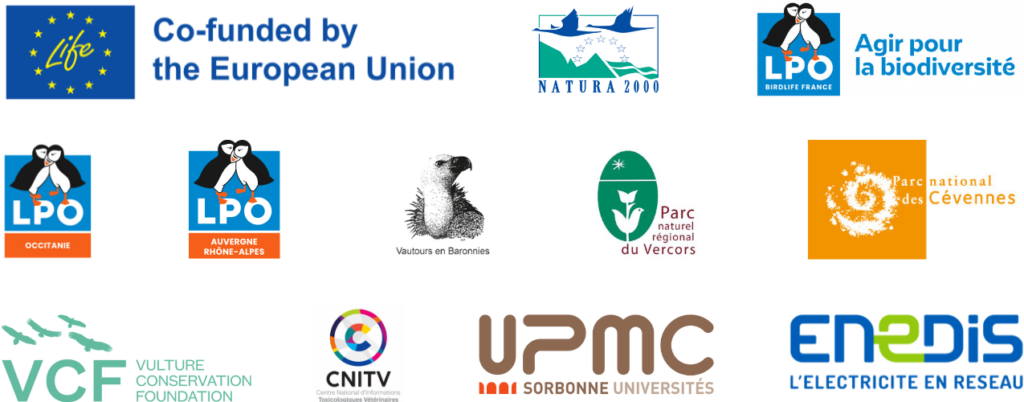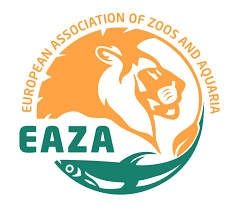Four female Bearded Vultures (Gypaetus barbatus) were successfully released this season in Grands Causses within the LIFE Gyp’Act project. While “Tarn” and “Tourmente” -released 18 June 2024- are still getting used to their new surroundings, “Terre” and “Tornado” -released 13 May- are already familiar with their new life in Southern France.

Meet Terre and Tornado
Both vultures released on 13 May 2024 hatched at Guadalentín specialised breeding centre, coordinated by us at the Vulture Conservation Foundation (VCF) under an agreement with Junta de Andalucía. They were named Terre and Tornado by the young students of the Vébron school.
Terre (BG1202) hatched on 8 February weighing 132,3g and its evolution in the laboratory was perfect. It was adopted by the couple Andalucía and Salvia and grew well.
Tornado (BG1207) hatched few days later, 14 February, with a weight of 132,7g. First, Tornado was successfully adopted by female Keno as a lone. After that, it was adopted by the female Nona as a lone and became the first chick that Nona has ever raised!
The young vultures were transported together from Spain and at the release location in Lozere they were equipped with rings and GPS beacons by the technical teams of the LPO and the Cevennes National Park. They were then welcomed at the release site by their godmother, Marylène Pieyre (administrator of the National Park) and their godfather, Stéphan Maurin (President of the National Park).




These young females are constantly monitored by the LPO team to ensure their good health, their adaptation to the release site, and food availability.
Terre has adapted easily to her new surroundings and her wingbeat rate is increasing rapidly which means the first flight is about to happen soon. She has a great passion for food, and she spends most of her day eating.
Tornado took a little longer to adapt. However, after a week, she began to have a rate of daily wing beats greater than 50. She feeds more quickly than her friend Terre and she likes to feed on lamb’s feet. Like a true Andalusian, she spends her days taking a siesta nap in the sun.
Meet Tarn and Tourmente
On 18 June 2024, two more females were introduced into the Grands Causses. These two birds were named by the Lozère school children as “Tarn” and “Tourmente”. Like Terre and Tornado, Tarn also comes from our Guadalentín breeding center, where she hatched on 11 March 2024 with a weight of 159g. Its development in the laboratory was perfect and it was adopted by the male Elías as a lone chick.
Tourmente, on the other hand, travelled to her new home in Southern France all the way from Ostrava Zoo, Czech Republic. She hatched on 18 March and is just one week younger than her friend Tourmente.
The birds were released successfully, and they are currently being monitored with great attention by the LPO and Cévennes National Park teams. The monitoring team is responsible for collecting various data such as the time spent feeding, maintaining the plumage, or even the number of daily droppings. The number of wing beats performed is also recorded because it helps determine when the birds are ready to take off.

Next steps
Once the first flight has taken place, the monitoring will continue from a new location in order to have a visual view of the flying birds and their movements.
During this period, the birds’ flight time is carefully recorded along with the other data previously collected. Particular attention is paid to the choice of their perch for the night, to prevent any accidents, particularly those linked to proximity to human installations.
In order to accurately locate birds, monitors track their movements via telemetry using VHF transmitters. If the first flights are relatively short, the birds tend to stay close to the ledge to which they return regularly to feed and rest. With experience, they will gradually begin to cover increasingly greater distances and go beyond the reintroduction site.
From this moment on, their movements will be exclusively monitored by GPS data in the hope that one day they will return to settle in the Grands Causses.
Restoring the Bearded Vulture Alpine and Pyrenean populations
With these new releases, 40 Bearded Vultures have been released in the Grands Causses territory since the start of the reintroduction programme in 2012.
To restore the Bearded Vulture metapopulation between the Alps and the Pyrenees, the LIFE Gyp’Act project plans to release 60 captive-bred juveniles in different locations across Southern France and the Pre-Alps. The LIFE Gyp’Act builds on the legacy of the LIFE GypConnect and ensures the continuity of the conservation measures implemented so that Bearded Vultures continue to flourish.

LIFE Gyp’Act is a 13M€ project, co-funded by the EU’s LIFE programme, that will run until 30 November 2028. Project partners are LPO – Ligue pour la Protection des Oiseaux as coordinator beneficiary, and the Vulture Conservation Foundation, Association Vautours en Baronnies, LPO Auvergne-Rhone-Alpes, LPO Occitanie, Sorbonne Université, ENEDIS, Centre National d’Informations Toxicologiques Vétérinaires, Parc National des Cévennes and Parc Naturel Régional du Vercors as associated beneficiaries.






